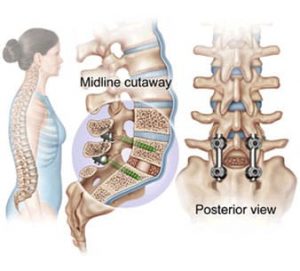Spinal fusion surgery is designed to stop the motion at a painful vertebral segment, which in
the turn should decrease pain generated from the joint.
How Spinal Fusion Works
At each level in the spine, there is a disc space in the front and paired facet joints in the back.
Working together, these structures define a motion segment and permit multiple degrees of
motion.

Two vertebral segments need to be fused together to stop the motion at one segment so that
an L4-L5 (lumbar segment 4 and lumbar segment 5) spinal fusion is actually a one-level spinal
fusion. An L4-L5, L5-S1 fusion is a 2-level fusion.
How Spinal Fusion is done
A spine fusion surgery involves using a bone graft to cause two vertebral bodies to grow together
into one long bone. The bone graft can be taken from the patient'ship (autograft bone) during the
spine fusion surgery, harvested from cadaver bone (allograft bone), or manufactured (synthetic
bone graft substitute).
In addition to choices about which/how many levels to fuse and which bone graft to choose,
there are many types of spinal fusion, including fusions with surgical approaches from the front
(anterior), the back (posterior), both front and back, and/or from the side. There are many
approaches to lumbar spinal fusion surgery and all involve the following process:
Adding bone graft to a segment of the spine
Set up a biological response that causes the bone graft to grow between the two
vertebral elements to create a bone fusion
The boney fusion – which results in one fixed bone replacing a mobile joint – stops the
motion at that joint-segment
Why Spinal Fusion is done
For patients with the following conditions, if abnormal and excessive motion at a vertebral
segment results in severe pain and inability to function, a lumbar fusion may be considered:
Lumbar Degenerative Disc Disease
Lumbar Spondylolisthesis (isthmic, degenerative, or postlaminectomy spondylolisthesis)
Other conditions that may be treated by a spinal fusion surgery include a weak or unstable spine
(caused by infections or tumors), fractures, scoliosis, or deformity.
Types of Spinal Fusion
There are several types of spinal fusion surgery options. The most commonly employed surgical
techniques include:
Posterolateral gutter fusion – the procedure is done through the back
Posterior lumbar interbody fusion (PLIF) – the procedure is done from the back and
includes removing the disc between two vertebrae and inserting bone into space
created between the two vertebral bodies
Anterior lumbar interbody fusion (ALIF) – the procedure is done from the front and
includes removing the disc between two vertebrae and inserting bone into space
created between the two vertebral bodies
Anterior/posterior spinal fusion – the procedure is done from the front and the back
Transforaminal lumbar interbody fusion (TLIF) – Similar to the PLIF, this procedure is also
done from the back of the spine
Extreme Lateral Interbody Fusion (XLIF) – an interbody fusion in which the approach is
from the side
It is important to note that with any type of spine fusion, there is a risk of clinical failure (meaning
that the patient's pain does not go away) despite achieving a successful fusion.
Successful Fusion
Obtaining a successful result from a spine fusion requires a number of factors, including an
accurate preoperative diagnosis, a technologically adept surgeon, and a patient with a
reasonably healthy lifestyle (nonsmoker, non-obese) who is motivated to pursue rehabilitation
and restoration of his or her function.
